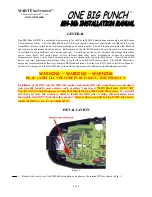
CompAir Limited
page 26
OPERATION
1.
COMMISSIONING/STARTING
PROCEDURES
When commissioning a new compressor or one
which has been overhauled or out of service for an
extended period, carry out the following procedure.
1.1 Static Checks
1.
Check that the isolator switch is locked 'OFF'
and that all electrical connections are tight and
correctly made and comply with the wiring
diagram. In the case of Vee-belt drive, check
the belts for condition, tension and alignment.
2.
Check that all blanking covers and protective
tapes have been removed. With oil-free models
ensure that the delivery valves have been taken
from their shipping locations inside the
distance pieces and fitted in the cylinder
heads.
3.
Check that all air intake piping is clean, free
from corrosion and contains no loose debris.
Note:
If the main air system is being used to
supply delicate instrumentation it is
permissible, for the initial run only, to fit gauze
filters in the air intake line and the downstream
line from the receiver to trap small particles
which may be present, particularly in extended
intake lines. Ensure that all gauze filters are
removed on completion of the initial run. Do
not connect the delivery manifold flange to the
pipework at this stage. The initial run will allow
the cylinder inhibitor, which is slightly toxic, to
disperse without entering the user’s pipework.
4.
Fit the air intake silencer/filter assembly.
5.
If the compressor has been in storage for a
lengthy period, remove all suction and delivery
valves and inspect to ensure that they are in
good condition.
6.
Check that ambient temperatures are within
limits and that ventilation of the compressor is
satisfactory.
7.
Check that the cooling water supply is
adequate and clean and that any water
treatment equipment is in order.
8.
Check that the aftercooler and air receiver are
correctly installed and that the air pressure
relief valves operate correctly.
9.
Prime the lubrication system as follows:
Disconnect the oil pipe between the crankcase
and the oil pressure switch at the switch end.
Connect a pressure oil can to the free end of
the pipe. Remove one of the crankcase doors
so that the connecting rods are visible. With
the recommended oil in the can, pump oil into
the pipe until oil is seen to flow from the small
end bushes. Disconnect the oil can and
reconnect the pipe to the oil pressure switch.
Refit the crankcase door.
10. Remove the oil filler cap and pour in the correct
quantity of the recommended oil (9 or 18 litres,
depending on model). Check that the oil level
is at the maximum level on the dipstick. Refit
the oil filler cap.
z
Refer to the safety procedures before
operating the compressor unit.
WARNING
z
Lethal voltages are used in this equipment.
Use extreme caution when carrying out
electrical checks. Isolate the power supply
before starting any maintenance work.
Summary of Contents for EO40/0001
Page 12: ...CompAir Limited page 10...
Page 16: ...CompAir Limited page 14...
Page 17: ...page 15 V100 VL400 User Manual 3 LEADING PARTICULARS...
Page 39: ...page 37 V100 VL400 User Manual 7 FAULT FINDING...
Page 44: ...CompAir Limited page 42...
Page 45: ...page 43 V100 VL400 User Manual APPENDIX 1 The Pressure Systems Safety Regulations 2000...
Page 48: ...CompAir Limited page 46...
















































